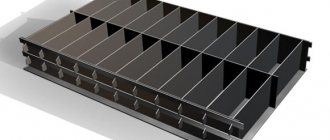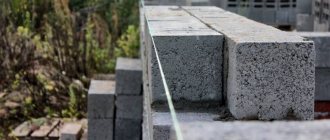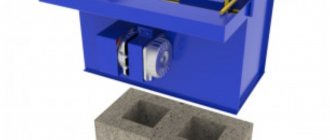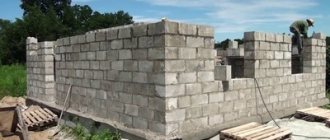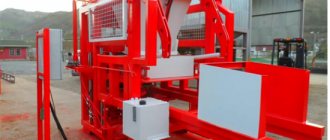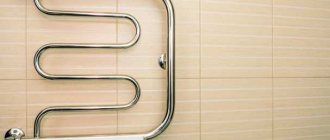Therefore, the elements can be manufactured in self-made devices. Let's figure out how to do this correctly so that neither the dimensions of the products nor their performance indicators are affected?
What are blanks?
Since cinder block material varies in size and appearance , there is no single template from which standard products can be produced. Therefore, in the production of slag concrete, special collapsible containers are used, consisting of 4 walls, a bottom (in some types of blanks a bottom is not provided) and matrices (one or several replaceable ones, depending on the size and size).
The number of matrices depends on the volume of products that need to be produced in 1 day. Matrices can be made of wood or metal.
Types of designs
Blanks for the production of cinder blocks are divided according to the material from which they are made and the number of voids in the future product. For the first category, you can write the following. They are:
- Plastic.
- Wooden.
- Metal.
Plastic
Plastic blanks for cinder block products on an industrial scale are not particularly popular. They will not be able to withstand constant pouring over a long period of time . This greatly limits their scope of application. Therefore, only a few manufacturers produce for sale plastic containers for pouring slag concrete.
The plastic structure comes in only one size – 390x190x188 mm.
But the advantage of such structures is that they are light in weight and easy to operate , because the walls of the workpiece do not need to be lubricated each time with used machine oil or a special self-destructive lubricant. In addition, their price is much cheaper than the same products made of metal or wood.
Wooden
Wooden structures are a rectangular box made of laminated plywood. They can be used both in production for the manufacture of large volumes of products, and for home production of cinder blocks.
To give the walls greater rigidity, clamps are used that tighten all 4 walls . And so that the cinder block solution does not destroy the structure from the inside, the bottom and walls are covered with polyethylene.
The advantages of containers made of wood are their average, affordable price (lower than those made of metal), light weight, making the workpieces easy to move around the site and lift, as well as the number of fills - on average 50 times.
But there is also a minus - the material is sensitive to moisture , so pouring the solution into wooden forms should only be done in the fresh air, in dry weather, and the filled forms should be stored in a well-ventilated, not damp area.
Metal
Metal forms come with or without a bottom. And the presence of a bottom divides metal products into solid and collapsible. If there is no bottom in the mold, then the walls of the product do not have sufficient rigidity, so in industrial production they mainly use blanks with a bottom 6 mm thick.
The bottom can be further strengthened with channels, and special metal inserts can also be used, which will allow the production of cinder blocks with a tongue-and-groove system (for partition slabs).
The most popular metal forms are made into 35, 63 or 70 blocks of standard sizes 390x190x188 mm .
Production of cinder blocks
In order to save material, it is recommended to use molds for the production of four to six blocks at once. To create cavities, they must be equipped with cylinders .
Step-by-step process for making blocks in split form:
- The solution is mixed using a concrete mixer.
- The mixture is poured into the mold with a shovel. In this case, the matrix must stand on a flat surface.
- The container should be filled evenly with the solution. This needs to be monitored closely.
- After the mold is filled to the brim, the top layer is leveled with a shovel.
- For dry mortar, a special lid with holes is used that will cover the existing bayonets in the matrix.
- The building block, together with the container, is moved to an open area, where it will be stored in the future.
- After about half an hour or a little more, the bottom, side walls and lid are removed. To make it easier to remove the cinder block, you can use a regular hammer to knock out the longitudinal strip with the cylinders and the walls.
about three days for the building blocks to dry completely .
Is it possible to make it yourself?
For a large volume of cinder block production, you need not to have homemade equipment and blank molds, but high-quality devices that would create the ideal geometry of the products.
But in order to make blocks only for private, small-scale construction, it is not necessary to buy expensive tools and equipment . You can make molds for cinder concrete with your own hands, simply using available materials.
Even if you don’t have the material at home from which you can make molds, you can ask your neighbors, family and friends. Surely, in the bins of their garage, shed or attic there are several pieces of sheets of steel, metal, iron, wood, and boards. A little active search and perseverance - and materials for blanks will be found.
To build your own molds you will need:
- material for the walls of the mold (metal, iron, wood, plastic);
- self-tapping screws, bolts, nuts - for twisting elements together;
- grinder, metal scissors, hacksaw - for cutting the material into the required pieces according to size (depending on what material will be chosen);
- vices and clamps - for connecting the sides of the form and giving them rigidity;
- welding machine;
- a sheet of metal or steel to create the bottom (approximately 3-6 mm thick);
- a pipe with a diameter of about 9 cm or wine or champagne bottles - to create voids in the future block;
- fittings with a diameter of 12 mm.
General information about foam block
Before you start creating molds for foam blocks, you should understand what they are. And so, foam concrete consists of sand, cement, foaming agent and water. In addition, to improve certain properties of the material, as well as to increase its strength, it is allowed to add hardeners, plasticizers and fiber.
What is a foaming agent
A foaming agent is an organic or protein-based liquid. This is an environmentally friendly, chemically neutral product. There are two types of foaming agents on the market - protein and synthetic. .
Protein foaming agents have the following properties:
- They have virtually no effect on increasing the setting and hardening time of the foam concrete solution.
- They practically do not degrade the strength of foam concrete.
- They give the foam concrete mass high durability.
- They have weak resistance to all kinds of accelerators, but their addition, as a rule, is not required.
- Using protein foaming agents, it is possible to obtain foam concrete with a density of 300 - 1200 kg/cm3.
Synthetic foaming agents have the following properties:
- Increases the setting and hardening time of the foam concrete solution.
- Significantly reduces the strength of foam concrete.
- Reduces the durability of the foam concrete mass.
- Resistant to various accelerators.
- They do not allow the production of low-density foam concrete.
Properties of foam concrete
The use of a foaming agent gives the material a closed porous structure, i.e. inside the material, the bubbles are isolated from each other. This provides it with high heat-protective and frost-resistant characteristics. In addition, foam concrete does not absorb moisture, unlike many other porous building materials.
Block Dimensions
Instructions for creating homemade containers
Containers for homemade molds can be of different sizes, both standard and non-standard. It all depends on the wishes of the owner and his preferences.
Please note : the larger the blocks, the less mortar will be needed to lay them and the fewer cold bridges there will be through the seams between the products.
Large blocks in size are convenient and practical, but it is better not to make forms over 2 m in length or width , because such formwork will be bulky and difficult to transport and lift. It is better to make several formworks, but smaller ones.
To make your own mold, you need to:
- First, decide on the dimensions of the future workpiece, and then cut out the building material according to these dimensions (4 walls, bottom and, if necessary, partitions).
- Set the height of the elements and cut the walls to this height.
- The walls of the formwork must be mounted in such a way that the transverse parts are inserted into the longitudinal ones and thereby form cells of the same size.
- Form the bottom from building material or line it with cellophane instead of the bottom.
- If you need to make hollow cinder blocks, then you will also need void formers for these purposes. They can be wine or champagne bottles filled with water. Bottles can replace pipes with a diameter of about 6 cm or rectangular wooden blocks.
- Insert void formers into the container and secure them. The number of voids in the finished product should not exceed 40% of the total mass of the block.
- Pour the solution and wait a day so that the material can be removed from the mold and transferred to the place for subsequent drying.
Material requirements
The first requirement relates to block size. Dimensions are standardized: 390-190x188 millimeters. This is the optimal size for building walls. As an option, you can make blocks of 400200x200 millimeters, such parameters are also acceptable.
But the basic requirements relate to the components of this material. The ingredients used are:
- coal slag (where the name of the material comes from), which can be replaced with zytoconcrete,
- expanded clay, pre-crushed,
- gravel,
- cement,
- water.
Instead of the standard filler, you can use other additives: gypsum or crushed stone, ash or sand, as well as perlite. Before starting a large production, I recommend experimenting with the components, since they affect some characteristics of the finished product: for example, strength and thermal conductivity.
Ingredients should be chosen carefully, because the quality of the final product depends on it. Cement, for example, must have a strength grade of at least M400. Gravel should be taken with fractions from 5 to 10 millimeters.
I’ll say something about water. For some reason, many people believe that the production of building materials is rough work, and therefore you can splash liquid from the nearest swamp into the composition, cement will tolerate everything. In fact, this can ruin any endeavor.
Water taken from a river or other nearby body of water is not clean. This will directly affect the characteristics of the finished product, reducing performance. For example, such water contains various organic impurities. During the production process, they will begin to rot, releasing air. And excess air in the structure of the material automatically means a loss of strength characteristics.
In general, it’s not worth saving money and effort on such a seemingly simple thing as water. You need to take one that you personally can drink without boiling. Only then can the manufactured material boast high quality.
No less important than the quality level of the ingredients is their proportions. To obtain the correct mixture you will need 7 parts of slag, 2 expanded clay, 2 gravel, 1.5 cement and 3 water. During the mixing process, regularly test the resulting result.
To do this, scoop up a handful of the mixture, squeeze it to form a lump, and drop it on the floor. Two points are important: initially the lump should stick together well, and when it hits the floor surface it should crumble. This means that all proportions are correct.
Difficulties and errors during work
If a person does not have the ability to work with his own hands, then it is better not to undertake making cinder blocks on his own. Despite the fact that cinder blocks may not be a certified product, they must be manufactured using technology. Therefore, it is necessary to carefully calculate the dimensions of the walls and bottom of the formwork so that the finished blocks are of the correct shape and dimensions.
For better production of cinder blocks, you need to use additional equipment, such as a vibrating machine. This will allow you to compact the product and give it the desired shrinkage. But you will either have to buy such equipment or make it yourself.
If you do not lubricate the mold walls with machine oil, oil paint or special lubricant before pouring the solution, then it will be very difficult to remove the products from the workpiece. The elements should be removed from the mold the next day , but so that they do not crumble in your hands when removing them.
To avoid difficulties and not make mistakes when making cinder blocks at home, it would be useful to watch a video on this topic:
Types of cinder blocks
There are two types of building blocks:
- Solid cinder blocks are used for the construction of foundations, load-bearing partitions and walls.
- Hollow ones are much lighter, so they do not create a load on the foundation. In addition, they have good heat and sound insulation. Due to these characteristics, hollow blocks are used to build walls.
The very first building blocks were made from slag and a binding material in the form of cement. are obtained from concrete mortar using vibrocompression . In addition to slag, their composition may include:
- granite crushed stone;
- granite screening;
- volcanic ash;
- fight of concrete and brick;
- sand;
- river gravel, crushed stone;
- expanded clay;
- broken glass;
- cement;
- broken hardened cement;
- battle of concrete and brick.
Do-it-yourself production of building blocks can be done using a vibratory pressing machine or wooden molds .
